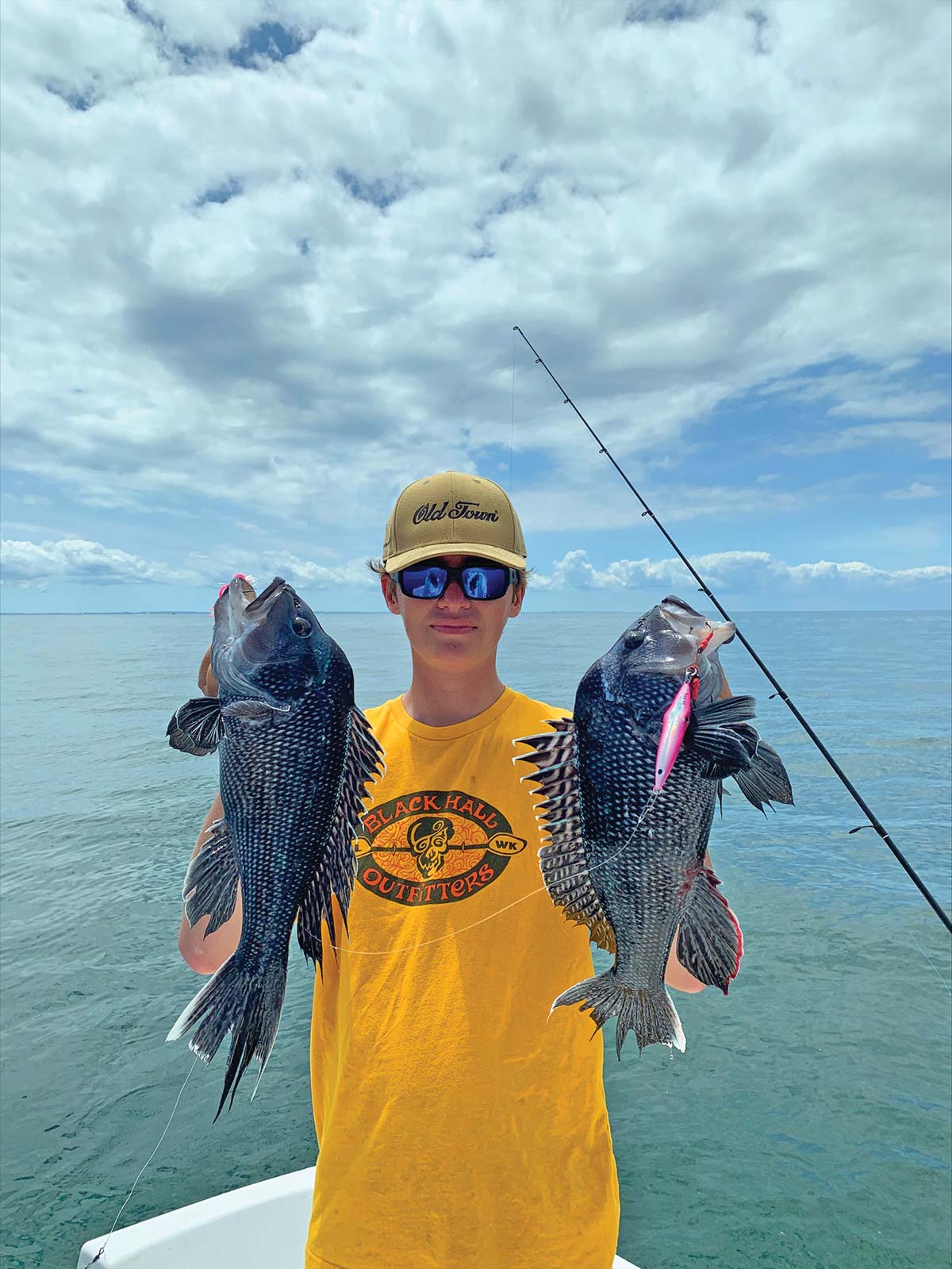
Fishing deep with a light tackle twist.
Slow pitch fishing was practically unheard of in the Northeast prior to 2018, but those that were doing it were very successful. This style of fishing using a light and limber rod and jigs that flutter and glide to the bottom – in a way it’s the opposite of something like diamond jigging, which are designed to get to the bottom in a hurry.
Slow pitch is a popular way of catching pelagics and bottom fish down south, which has only recently gained popularity with tuna and groundfish fishermen in along our northern stretches as well. Unlike speed jigging, slow pitch jigging entices fish to eat the jig on the fall, by mimicking a dying baitfish. The slower descent and fluttering action makes it possible to entice inactive fish into taking a shot at you jig.
Slow pitch jigging involves using a moderate action rod that doubles over when hooked up to a fish. This makes for an extremely fun fight and lowers the chance of losing the fish, thanks to the moderate rod absorbing headshakes and sudden runs. Additionally, slow pitch setups are well built and wicked light, making it easy to keep fishing all day. If I’m fishing for sea bass, 99% of my time is spent slow pitch jigging for them, often outfishing those in the same boat as me 5:1. It is an extremely effective method of catching more and larger fish with a fun light tackle twist.
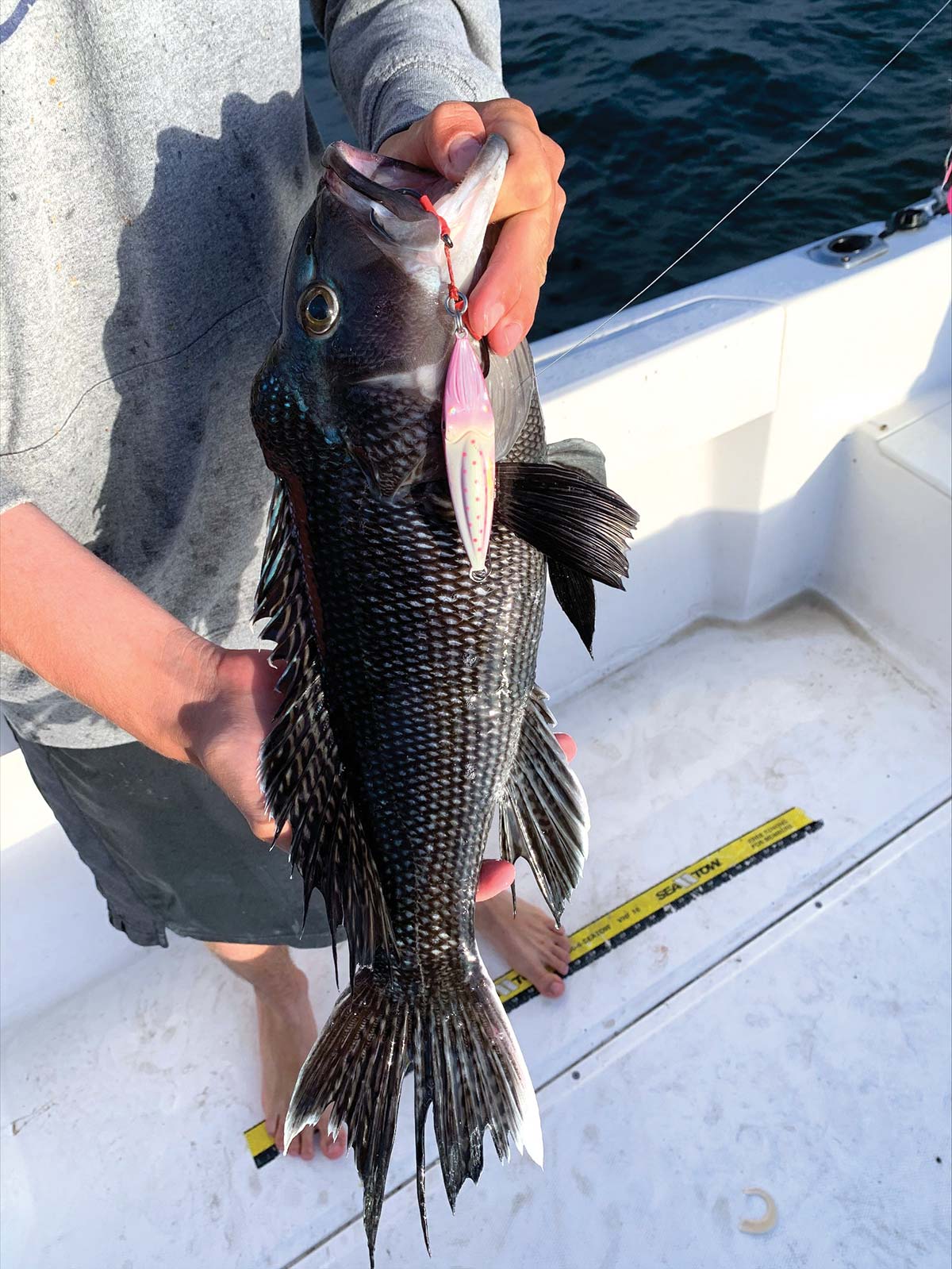
Rods For The Job
Slow pitch fishing combines the use of a moderate action rod, thin line, and a lightweight reel. Sea bass can range in size from your common “squeaker” of 13 inches or even less, up to over 24-inch “hump heads”. Making sure you have the proper rod for this type of fishing is crucial. You want something that can handle big fish and heavy jigs, but is also light enough for a full day’s fishing.
For someone just starting out with slow pitch I suggest using a spinning outfit. A good rod consists of a moderate action, medium-medium heavy power, with a comfortable grip and butt end of the rod. The butt end of the rod is very important to consider, because you will be jigging the rod with full sweeps, where the end of the rod will be rubbing against your armpit through the duration of the day. Personally I like split grips, where most of the rod blank is exposed, so that just the blank is in my armpit. Of course everyone will have their preference, but I encourage you to spend time in your local tackle shop, trying different rods, finding what feels best.
Throughout my 5-plus years of slow pitch fishing, I have tested and tried many different rods. An important factor to keep in mind here is that many of the available rods are what I call “Americanized”, meaning they don’t have the true moderate action and are a stiffer than a true Japanese-style slow pitch rod. Some that really stuck out as frontrunners were the Tsunami Trophy Series Slow Pitch rods. Retailing for about $90, this budget friendly rod offers everything you want in a slow pitch rod, without the crazy price tag. I currently own three, and they have withstood the test for the 3 years of owning them. For sea bass you’ll want the 661MHC (casting) and/or 701HS (spinning). They provide a pretty moderate action for being an “americanized” rod, they feature split grips and the casting version features an acid wrap to reduce twisting when tight to a fish.
Another rod that I have had great success with is the Daiwa Harrier slow pitch series rods. These retail just under $200, and have many benefits over rods at this price point. I like the Harrier because of the true slow pitch design, where the moderate action is very pronounced when hooked into a good fish. I own a 66MHB, which I found to be the perfect fit for inshore slow pitch fishing. This rod has enough backbone to handle big sea bass and slot stripers, yet will bend into a complete ‘U’ making for a fun fight. My favorite feature about this rod is the sleek split grip styling on the butt end. The rod blank is pretty much fully exposed from the reel seat down, providing excellent sensitivity and comfort in my armpit.
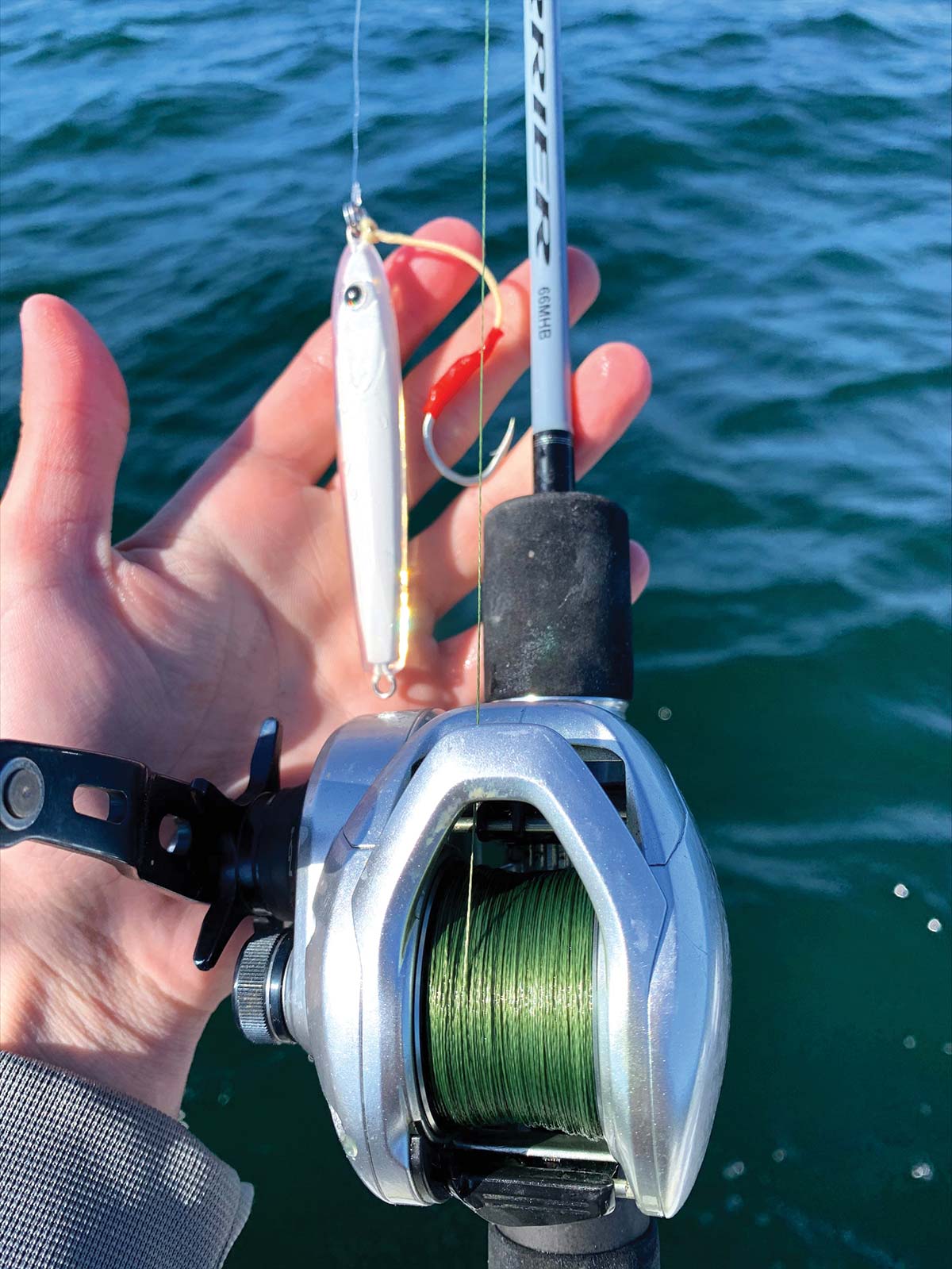
Reel & Line
When it comes to slow pitch fishing, the reel is not as important as the rod, but the reel must fit the rod well, meaning slim fit to the reel seat, to eliminate the torque when reeling in a fish. There is no “desirable” gear ratio for slow pitch fishing, although I prefer a faster reel. It all depends on if you prefer to take the fight slow and steady with less effort, or if you like to get the fish up fast. For a spinning reel outfit, you want something light and smaller in size to fit the rod well. For a budget friendly reel I suggest the Daiwa BG, specifically the 3000 size. The BG is a relatively light reel, yet rugged and robust enough to last a few seasons. I have a BG 3000 on a Tsunami Trophy slow pitch 701HS and find it to be a great setup for this type of fishing.
If you are more into the higher end reels, the Shimano Twin Power 5000 XGFD is the perfect match for a light and sensitive slow pitch rod. For conventional reels, I highly recommend the Shimano Tranx 300HG. Coming in at $279.99, the Tranx is the perfect reel for conventional slow pitch fishing because of its ease of use. With the Tranx (and other baitcaster-style reels), the thumb bar allows you to let line out effortlessly when your jig starts to scope out. I own three Tranx’s they’re trouble free and have been a perfect fit for slow pitch fishing.
| COLOR THEORY |
| When considering jig colors I haven’t really found that one is better than another. It’s more of a technique thing when it comes to the high hook. However I have stuck with glow, pink, and silver colors when fishing for sea bass. The glow is always a killer, but when fishing heavily pressured areas, silver or pink may be better because it is more natural to the fish. |
The line you use is super-important; you’ll be fishing deep water and oftentimes in strong current. This means the diameter of your line should always be a consideration. You will often be dealing with ‘scope’ which is a term used to describe the current pushing your line out away from the boat. On some days, even your heaviest jigs won’t hold and this is when line diameter will play a role in your jig control.
I like to fish 15- or 20-pound braid, preferably an eight-strand. The eight-strand line is thinner and smoother, causing less resistance in the water. And because much of my sea bass f fishing is done in 50 to 140 feet of water, the thinner the line the better. I highly recommend Daiwa J-Braid 8x Grand, it’s super smooth and thin and can withstand multiple seasons of use before replacement.
For leaders, I like to use 4- to 6-feet of 30-pound fluorocarbon, with a TA clip.
Pitch Selection
Now into the nitty gritty part of slow pitch jigging. There are many different types of jigs on the market, all have a place and time. I suggest using those that are center-weighted or evenly distributed jig. This causes the jig to flutter, shimmy or spiral down during the descent. Different shapes and sizes will offer different actions, don’t be afraid to experiment. When it comes to sea bass, I like Daiwa SK jigs. They come rigged with assist hooks, the paint is durable and their action could be best described as a ‘spiraling quiver’ – similar to a squid darting away from a predator.
Another that I like are the Savage Squish jigs. These are more compact with realistic eyes and details, and an array of colors. These also come rigged with assist hooks. Weights will vary depending on depth and current, but I typically fish 85 to 140 grams in 70 to 100 feet of water with a typical 0.5- to 1.5-knot current. Anything heavier becomes hard to jig consistently. It’s always best to keep your jig as light as possible, while still keeping the jig from scoping too far out. When fishing lighter jigs I like to use the Game On 1.5-ounce Exo Jig, rigged with a single assist hook. Light jigs like the Exo excel in slower current conditions because they have a slower fall rate and will trigger more bites. The number one rule when slow pitch jigging is to keep your fall rate as slow as possible, this will lead to more bites.
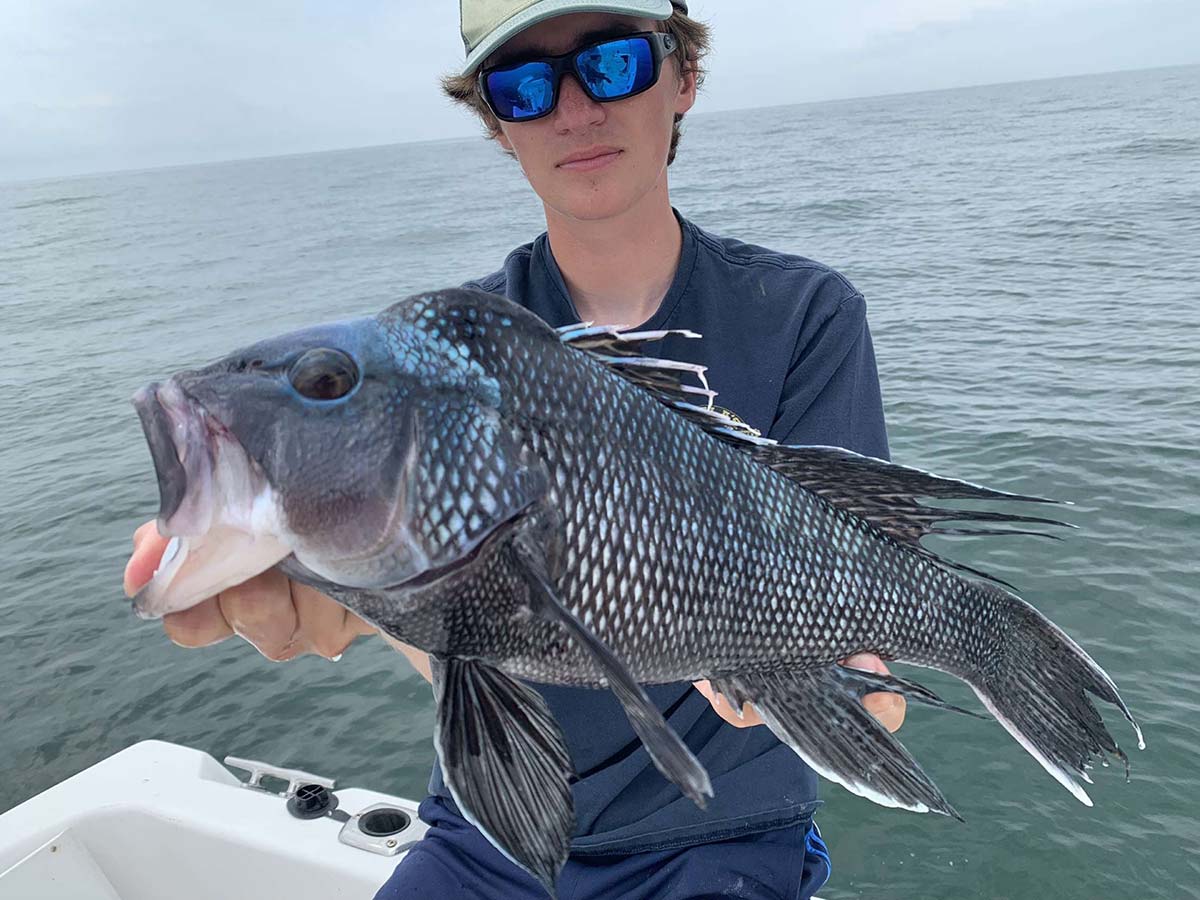
Timing & Technique
Slow pitch works at all times of the year, but it works especially well in the late spring when sea bass move shallow to spawn. Typically the fish are much larger when fishing on spawning grounds, and super aggressive. The jigs work especially well at this time because of that aggression, the movement triggers bites that a baited hook probably would not. Target large sand flats surrounded by deep water, or sandy gullies that cut through shallower flats or shell beds. Sea bass will congregate by the thousands on any of these softer bottom areas to spawn.
| TWO POINTS, TWO ASSISTS |
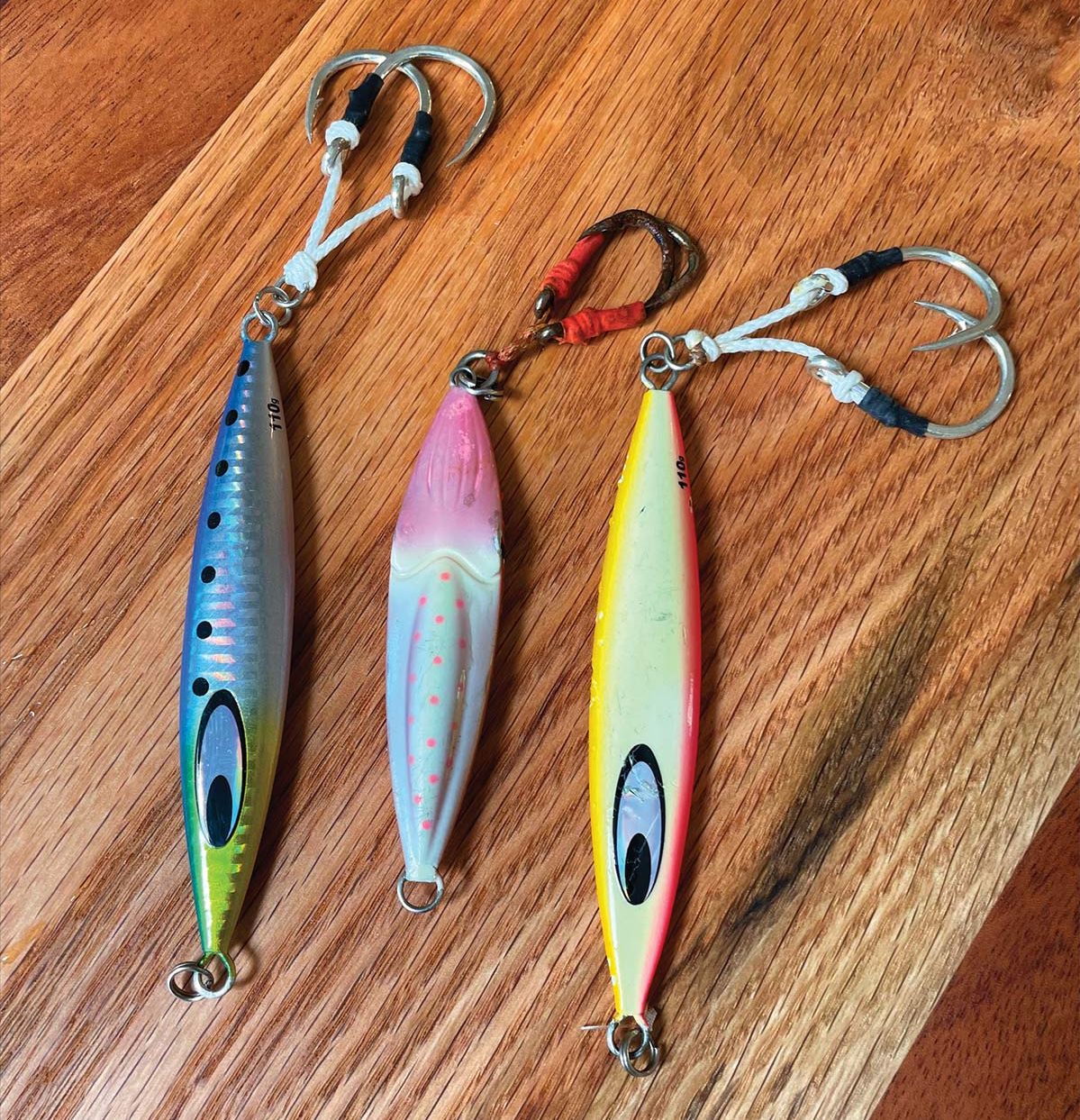
Some slow pitch jigs come, pre-rigged, with assist hooks, some will have them in the package but not rigged, and some won’t come with hooks at all. The key to getting more fish in the boat is your assist hook placement. Each jig will react differently to how you rig it. On some jigs the action and hookup ratio is best with just one assist hook, and on another it may do better with two. My experience has shown that two assist hooks on one jig will usually result in a better hookup ratio. When rigging a jig with two assist hooks I like to use an oversized split ring, giving the jig and hooks more freedom. I also like to rig the assist hooks to the bottom end of the jig, I feel this leads to more hookups and fewer tangles. However if I am running one assist hook on a jig, I like to attach it to the top end of the jig, which lessens the chance of that hook tangling with my line. |
The key to finding spawning areas for sea bass is to find areas with soft bottom, plenty of moving water and deep structure nearby. Slow pitch fishing in areas like these is a blast because you will never snag up and lose a $15 jig. Once late June hits, the sea bass will move to deeper water structures and wrecks where they will spend the summer and early fall. Slow pitch is a little tougher when fishing structure like this thanks to more snags and having a ton of line out, but it still effective and a great choice when dropping bait is only resulting in small sea bass or bycatch species. Another time that slow pitch works insanely well is when you find a fleet of boats fishing bait and bucktails on a piece of structure. Slow pitch will catch you more fish and bigger fish than the rest of the flotilla.
The main difference between speed jigging or diamond jigging compared to slow pitch jigging is the technique in which you work the jig. Slow pitch jigging defines the use of a moderate action rod that absorbs head shakes from the assist hooks to the jig, decreasing the odds of a fish shaking the hook. You want to start by using the lightest jig possible. Free spool the jig down to the bottom. If you feel that you hit the bottom too fast or the descent never stopped, set the hook and start reeling. Ninety-percent of the time, the fish will eat this jig on the fall. Once you hit the bottom, close the bail or engage your reel and begin making long sweeps upward with the rod. You can jig as hard or as soft as you want or find comfortable. As long as you give the jig slack on the fall, you will be giving it all the action you need. I find that a moderate jigging speed is best, too slow and they have too long to look at it, too fast and you may spook the fish. If your line begins to scope within the first 10 jigs, reel up and grab a heavier jig. If your jig still won’t hold vertical or somewhat under the boat, try casting up current, so that by the time you are in the strike zone your jig is vertical.
I find that I usually hook up to a fish within the first 10 jigs, so expect to be consistently hooking fish. When it comes to the hookset, you basically just keep the jigging motion going, and begin reeling down on the fish when you finish the sweep of the rod. It is crucial that you do not horse these fish in, the smaller hooks and heavy jig ‘between’ you and the fish will result in lost fish if you do. Just a steady crank is ideal.
The most important part is having fun, make sure your setup is light enough to jig all day, but has enough backbone to handle a jumbo!




